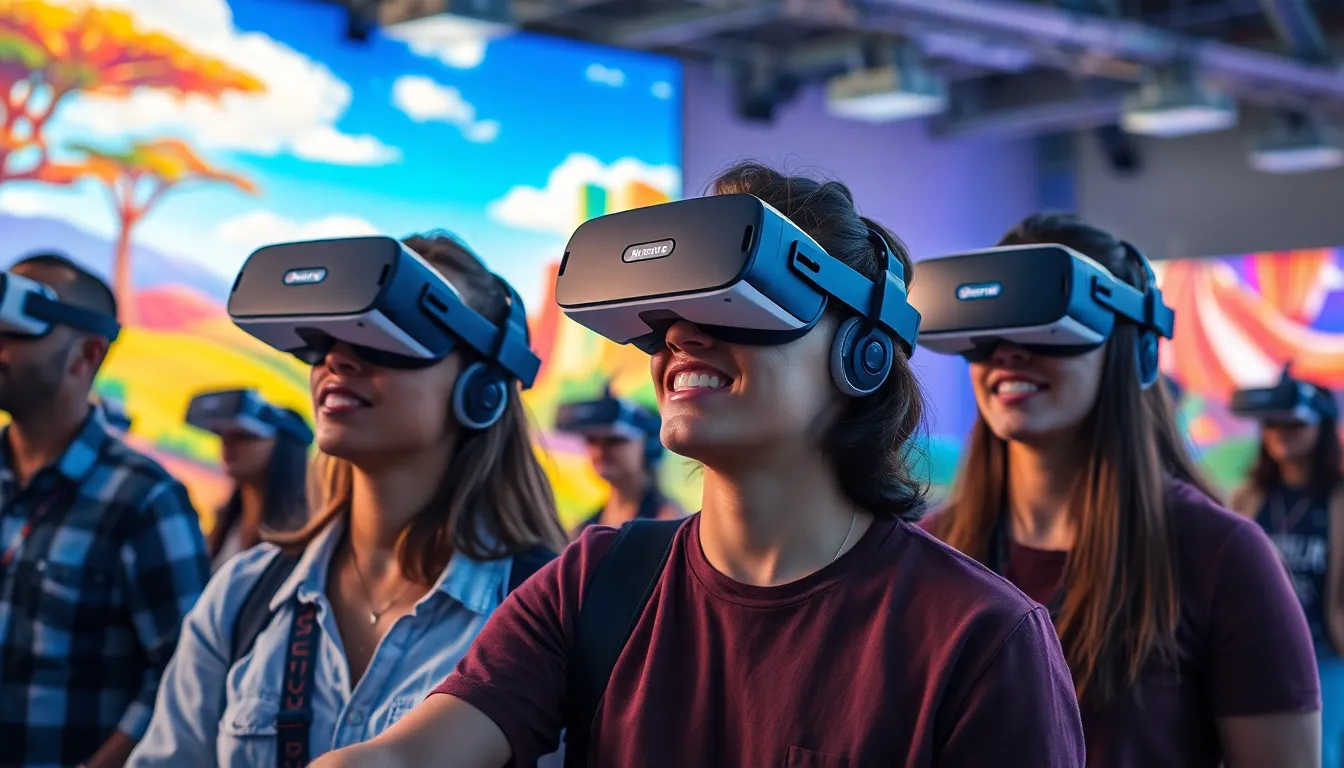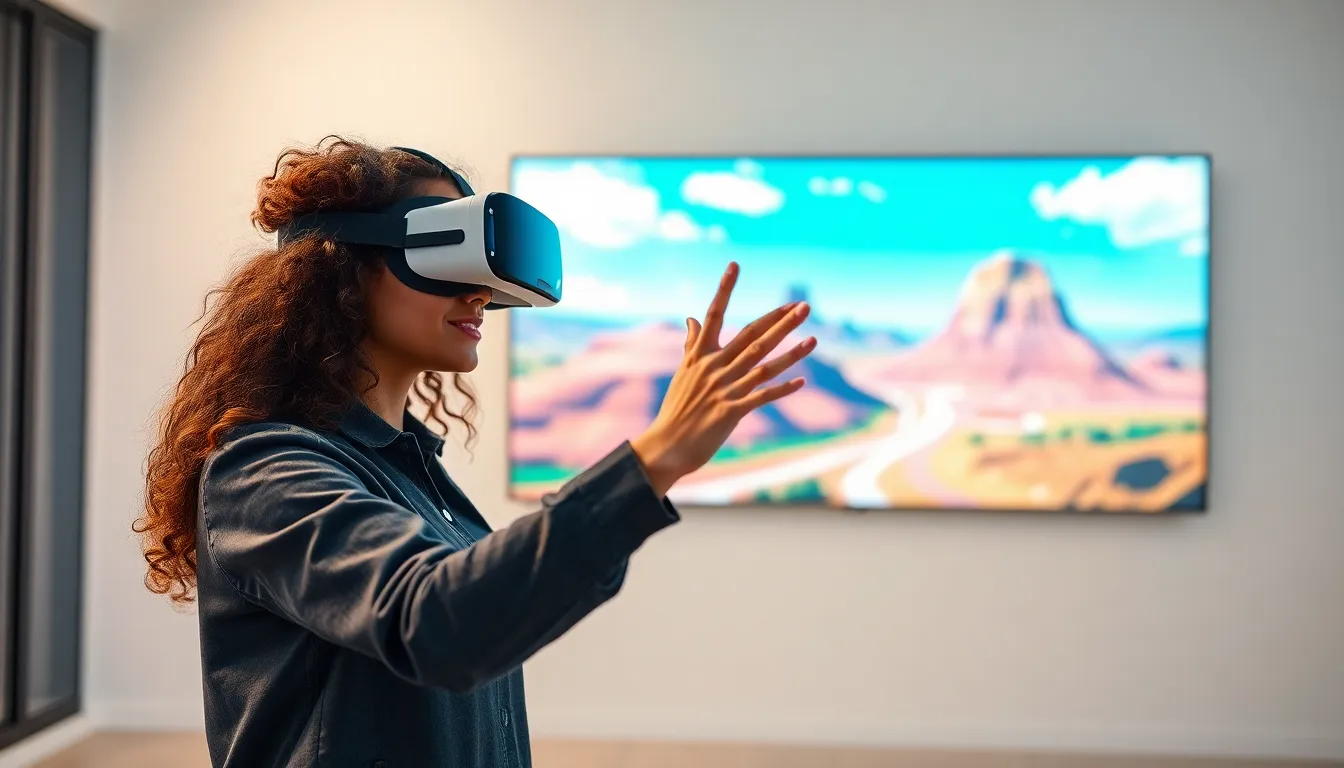Virtual reality technology is rapidly transforming the way people experience digital content. From gaming to education and healthcare, advancements in VR are redefining boundaries and creating immersive environments that were once the stuff of science fiction. With each breakthrough, users are drawn deeper into virtual worlds that engage their senses and enhance their interactions.
Recent innovations in hardware and software have made VR more accessible and user-friendly. Improved graphics, motion tracking, and haptic feedback are just a few of the developments pushing the envelope. As industries embrace these advancements, the potential applications seem limitless, promising a future where virtual experiences become an integral part of everyday life.
Table of Contents
ToggleOverview of VR Technology Advancements
VR technology has undergone significant advancements, reshaping experiences across various domains. Key improvements in hardware, such as lighter headsets and higher resolution displays, enhance user engagement. Enhanced graphics engines improved resolution to over 4K, providing crystal-clear visuals that increase immersion.
Motion tracking technology has evolved with the introduction of inside-out tracking systems, allowing for more precise movements without external sensors. This innovation enables users to interact naturally within virtual environments, making experiences feel seamless.
Haptic feedback has also advanced, incorporating more sophisticated vibration systems that simulate real-world sensations. Devices with advanced haptics provide realistic tactile feedback in applications ranging from gaming to training simulations.
Software development has followed suit, with diverse applications emerging in gaming, education, and healthcare. Educational VR platforms now offer interactive simulations for complex subjects, while healthcare professionals utilize VR for patient therapy and surgical training.
Adoption rates for VR technologies have increased, driven by lower price points and improved accessibility. More users can explore VR environments, further expanding the market. As VR continues to evolve, its applications and influence on everyday life are poised for substantial growth.
Key Innovations in VR Technology

Advancements in VR technology enhance user experiences across various domains. Innovations in visual clarity, motion detection, and tactile sensations significantly elevate immersion and engagement.
Enhanced Visual Experiences
Lighter headsets with higher resolution displays, often exceeding 4K, transform visual quality in VR. These displays offer sharp, vibrant graphics, enabling users to explore richly detailed environments. Technologies like OLED and AMOLED panels further deepen contrasts and colors, making virtual worlds more lifelike. Foveated rendering, which adjusts the graphical detail based on where the user looks, optimizes performance while maintaining clarity, providing a seamless experience.
Improved Motion Tracking
Inside-out tracking systems revolutionize user interaction. These systems eliminate the need for external sensors by using built-in cameras to track head and hand movements. Advanced algorithms enhance precision, allowing for smooth, real-time movement capture. Six degrees of freedom (6DoF) tracking empowers users to navigate virtual spaces dynamically, enhancing realism and interaction within various applications, including gaming and simulations.
Haptic Feedback Developments
Sophisticated haptic feedback systems create realistic touch sensations. These systems employ advanced motors and technologies to simulate feelings like texture and resistance. In gaming, players experience tangible interactions, such as weapon recoil or surface textures, enriching immersion. Training environments benefit from haptic feedback by allowing professionals to engage with scenarios that mimic real-life physical interactions, bolstering the effectiveness of simulations.
Applications of VR Technology
VR technology finds extensive applications across various fields, enhancing user engagement through immersive experiences and interactive environments.
Gaming and Entertainment
Gaming and entertainment benefit significantly from VR advancements. Players immerse themselves in realistic worlds, experiencing enhanced graphics and responsive environments. High-fidelity audio complements visuals, creating a multitiered sensory experience. Multiplayer VR platforms enable social interaction, allowing users to connect with others in virtual settings. Popular VR games like “Beat Saber” and “Half-Life: Alyx” showcase dynamic gameplay, increasing player retention and satisfaction.
Education and Training
Education and training sectors leverage VR to create engaging learning modules. Educators employ VR simulations to illustrate complex concepts, making them accessible and tangible. Students practice skills through realistic scenarios, improving retention and understanding. Industries utilize VR for employee training, allowing workers to navigate potentially hazardous situations in a safe environment. Companies like Google and Oculus offer platforms that facilitate collaborative educational experiences, transforming traditional learning models into interactive sessions.
Healthcare Applications
Healthcare applications of VR technology include therapy and surgical training. Medical professionals use VR for exposure to diverse patient scenarios, enhancing diagnostic and procedural skills. Therapists implement VR in treating conditions such as PTSD and phobias, providing controlled environments where patients confront their fears. Additionally, surgical simulations allow aspiring surgeons to practice techniques without risks, refining their skills. Institutions like Mount Sinai and Stanford incorporate VR into their training programs, yielding positive outcomes in both patient care and practitioner proficiency.
Challenges Facing VR Technology
Challenges in VR technology impact its growth and widespread adoption. While advancements continue, several hurdles persist.
Cost and Accessibility
Cost remains a significant barrier to VR adoption. High-quality headsets often range from $300 to $1,000 or more, limiting access for many consumers. Furthermore, associated equipment, like powerful PCs or gaming consoles, adds to the financial burden. Despite decreasing prices for entry-level devices, affordability remains an issue for broader audiences. Limited access to high-speed internet can also hinder experiences that rely on cloud-based VR applications. Companies must prioritize cost-effective solutions and create inclusive programs to enhance accessibility across diverse demographics.
User Experience Issues
User experience issues often detract from VR’s immersive potential. Motion sickness affects approximately 40% of users, stemming from lag, poor graphics, or disorienting environments. Additionally, the use of bulky headsets can lead to discomfort during extended sessions. Limited content also restricts user engagement, as many applications lack depth and interactivity. To improve performance, developers should prioritize user-friendly designs, optimize graphics, and create more varied, high-quality content. Enhancing the overall user experience is crucial for fostering sustained interest in VR technologies.
Future Trends in VR Technology
Future trends in VR technology indicate significant developments driven by artificial intelligence and enhanced social interactions, shaping immersive experiences across various industries.
AI Integration
AI integration enhances VR technology by enabling intelligent interactions and adaptive experiences. AI algorithms analyze user behavior, optimizing gameplay dynamics and personalizing content delivery. Machine learning enhances real-time environment adjustments, creating responsive virtual settings. For instance, non-player characters in VR games exhibit realistic behaviors, improving user immersion. Furthermore, AI aids in generating lifelike animations, streamlining content creation for developers. Companies like Unity and Epic Games are incorporating AI tools, facilitating efficient design processes in VR applications.
Social Interaction in VR
Social interaction in VR expands through innovative platforms that foster community engagement. Multiplayer environments now emphasize collaboration, allowing users to interact seamlessly in virtual spaces. Enhanced avatar customization and realistic interaction dynamics elevate user connection, enriching gaming and social experiences. Events such as virtual concerts and conferences flourish, connecting users globally regardless of physical location. Companies like Meta and Rec Room are spearheading these initiatives, creating social hubs where users can gather, share experiences, and build relationships in immersive virtual worlds.
The landscape of VR technology is evolving rapidly and its applications are becoming increasingly diverse. As advancements continue to enhance user experiences across gaming, education, and healthcare, the potential for VR is immense. With innovations in hardware and software making VR more accessible, users can look forward to richer interactions and greater immersion.
While challenges like cost and user experience remain, the future is bright. The integration of AI and the expansion of social interactions will likely redefine how people engage with virtual environments. As these technologies mature, VR is poised to become an integral part of daily life, transforming how individuals learn, play, and connect.



